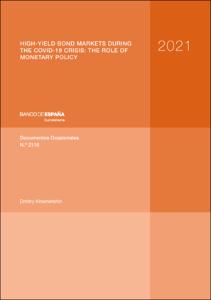High-Yield bond markets during the COVID-19 crisis: the role of monetary policy
Autor
Fecha de publicación
7-abr-2021
Descripción física
22 p.
Resumen
Este documento muestra la diferencia en la emisión de bonos corporativos entre el área del euro y Estados Unidos en 2020, especialmente en el segmento de alto rendimiento [high yield (HY)], y analiza cómo las medidas de política monetaria adoptadas por la Reserva Federal y el Banco Central Europeo (BCE) en respuesta a la crisis del COVID-19 pueden haber contribuido a explicar tal diferencia. Documentamos que la emisión de bonos HY desde febrero de 2020 ha sido relativamente menor en el área del euro que en Estados Unidos. Las medidas de la Reserva Federal dirigidas al segmento HY, principalmente la compra de fondos cotizados en bolsa [exchange traded funds (ETF)] compuestos de bonos HY, podrían haber reducido los diferenciales crediticios y mejorado la liquidez del mercado, lo que a su vez podría haber estimulado la emisión de deuda. Alternativamente, en el área del euro los emisores HY pueden haber disfrutado de mejores condiciones de financiamiento bancario debido a las operaciones de refinanciamiento a plazo más largo del BCE y a otras medidas de las autoridades fiscales nacionales, lo que ha llevado a dichos emisores a sustituir la financiación mediante bonos por crédito bancario. El documento analiza estas posibilidades y argumenta que todas ellas pueden haber desempeñado un papel hasta cierto punto.
This article documents the difference in corporate bond issuance between the euro area (EA) and the United States (US) in 2020, especially in the high-yield (HY) segment, and discusses the role that the monetary policy measures undertaken by the US Federal Reserve (Fed) and the ECB in response to the Covid-19 crisis may have played in explaining such difference. We document that the issuance of HY bonds since February 2020 has been lower by historical standards in the EA than in the US. The Fed’s measures aimed at the HY segment, mainly the purchase of HY bond exchange traded funds (ETFs), could have reduced credit spreads and improved market liquidity, which in turn could have stimulated debt issuance. Alternatively, HY issuers in the EA may have faced better bank funding conditions due to the ECB’s targeted longer term refinancing operations (TLTRO) and to other measures by national fiscal authorities, leading such issuers to substitute bank credit for bond finance. The article discusses these possibilities and argues that they all may have played a role to a certain extent.
This article documents the difference in corporate bond issuance between the euro area (EA) and the United States (US) in 2020, especially in the high-yield (HY) segment, and discusses the role that the monetary policy measures undertaken by the US Federal Reserve (Fed) and the ECB in response to the Covid-19 crisis may have played in explaining such difference. We document that the issuance of HY bonds since February 2020 has been lower by historical standards in the EA than in the US. The Fed’s measures aimed at the HY segment, mainly the purchase of HY bond exchange traded funds (ETFs), could have reduced credit spreads and improved market liquidity, which in turn could have stimulated debt issuance. Alternatively, HY issuers in the EA may have faced better bank funding conditions due to the ECB’s targeted longer term refinancing operations (TLTRO) and to other measures by national fiscal authorities, leading such issuers to substitute bank credit for bond finance. The article discusses these possibilities and argues that they all may have played a role to a certain extent.
Publicado en
Documentos Ocasionales / Banco de España, 2110
Materias
Programas de compras de bonos corporativos; Política monetaria; COVID-19; Corporate bond purchase programs; Monetary policy; COVID-19; Bancos centrales y otras autoridades monetarias; Teoría monetaría; Valoración de activos; Política monetaria; Zona euro; Estados Unidos
Aparece en las colecciones:












